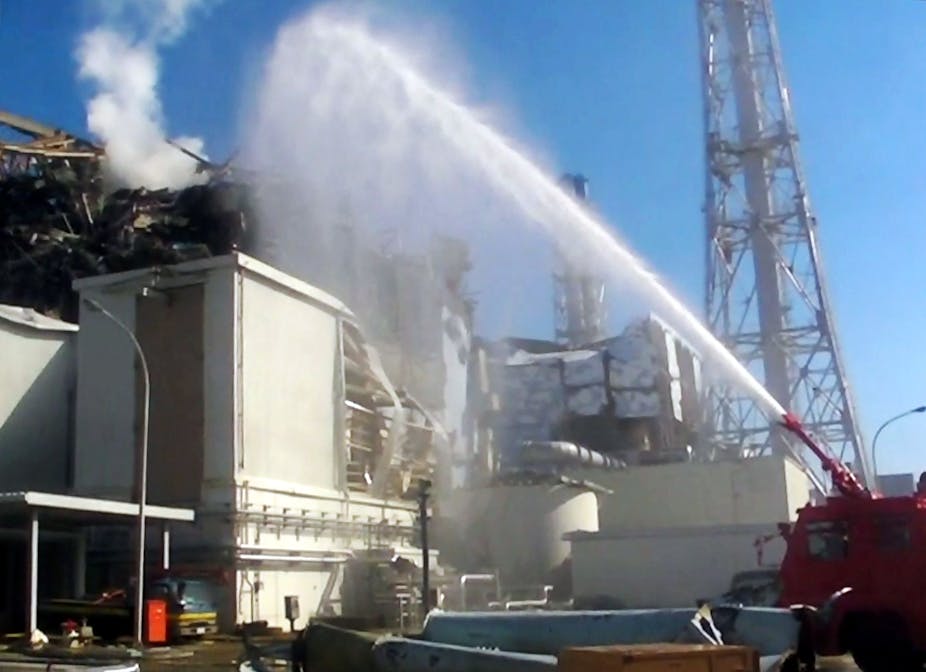Does the design and construction employed at Fukushima really represent the best that can be done in nuclear power?
Is it inevitable that a nuclear power plant will be overwhelmed by a magnitude nine earthquake followed by a 14 metre high tsunami wave? Will addressing these concerns mean nuclear power plants will become more expensive in the future?
To answer these questions it’s important to understand the basic operation of light water nuclear reactors.
The vast majority of nuclear power plants in operation around the world are light water reactors. These employ water to both enable nuclear fission and to conduct the heat from nuclear reactions to drive steam turbines used to generate electricity.
If the water is removed from the vicinity of the fuel, the nuclear reaction stops.
As the temperature of the fuel increases, the nuclear reaction rate decreases. Both these effects provide the inherent stability that enable fleets of nuclear plants to reliably generate large amounts of electricity.
The water in these reactors is heated under pressure in large pressure vessels, not fundamentally dissimilar to the those employed in coal-fired power plants in Australia.
The main distinctions are that nuclear reactors are built to much higher engineering standards and the heat is generated within the structure rather than from an external source.
Fukushima: what went wrong?
The design of the Fukushima Daichi originates from the 1960s. It has a relatively small containment structure and relies on multiple pumps to keep the water circulating. The containment structure and reactor components, like all those in Japan, were designed to withstand large earthquakes.
These responded exactly as expected when the earthquake hit: the fission process stopped and the safety systems were started to remove the decay heat. Approximately one hour later, the emergency diesel power generators were overwhelmed by the 14 metre tsunami that hit the facility.
Without electrical power, the pumps used to the transfer heat from the fuel rods stopped. This caused the water inside the reactor to heat up and evaporate. This in turn raised the pressure inside the reactor, dropped the water level and enabled superheated steam to chemically react with the fuel rods’ casing. This released hydrogen, which caused the subsequent explosions at the reactors.
More recent designs dating from the 1970s have much larger containment vessels surrounded by reinforced concrete domes. These are much better at dissipating the decay heat and their larger volume reduces pressure build ups within the structure.
Nuclear’s next generation
In the US, the Nuclear Regulatory Commission ‘defense in depth’ strategy was enhanced following the September 11 attacks to enable US nuclear facilities to cope with extended periods of station blackout.
Generation 3+ designs, like the newly-designed Westinghouse AP1000, rely on the laws of physics, not pumps, to keep the fuel covered with water and to provide cooling.
This design automatically de-pressurizes the reactor vessel, provides gravity-fed water from reserves held within the containment structure and employs natural circulation to provide cooling following an emergency shutdown.
Even total loss of power would not prevent the reactor from safety removing the decay heat from the fuel. This would prevent explosions if some combination of events enabled the build up of hydrogen.
In all, the AP1000 is a passively safe design that provides substantial ‘defense in depth’ against an array of potential threats, ranging from commercial airline crashes to extremely large earthquakes and total loss of electrical power.
The US NRC has conducted an exhaustive review of the AP1000 and has concluded that in a probabilistic sense it is 10 times safer than the reactors currently employed in the US fleet.
Does this mean that these advanced reactors are more expensive than the generation 2 reactors in large-scale use elsewhere in the world?
Actually it doesn’t. The use of passive safety makes for a considerably less complex design with fewer components and less that can go wrong.
Overall, the AP1000 uses one third the steel and concrete employed in generation 2 facilities. Compared to wind power, the AP1000 uses about one tenth the steel and concrete for the same generating capacity.
Why nuclear power will survive
So does the Fukushima crisis represent the end of the nuclear renaissance? I expect not. The renaissance has been driven by economics. The cost of fossil fuels including coal and natural gas has risen substantially in the 21st century.
The price of uranium, while increasing, is less than one twentieth that of coal compared to their respective energy content. In addition, nuclear power has far fewer greenhouse gas emissions than any fossil fuel technology. This eliminates a substantial risk with regards to CO2 emission charges. None of this has changed.
With regard to safety, the Japanese nuclear fleet has demonstrated remarkable resilience in the face of numerous large scale earthquakes. The failure modes of the Fukushima plant in the face of a 14 metre tsunami would not be experienced by the modern, passively safe reactors under construction now.
If AP1000s were built in Australia, they would probably be one of the few pieces of substantial infrastructure still in safe, working condition if Australia was subjected to a natural disaster of the scale experienced in Japan.

